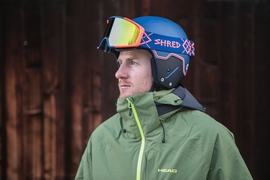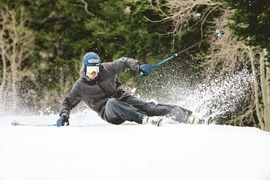Skiers taking to the slopes at the Olympics in Pyeongchang in a few weeks have a common enemy: flat light. Flat light occurs on overcast days when light diffuses through moisture in the air, creating a white-out effect that makes shadows and colors difficult to see. It impedes skiers’ ability to perceive the terrain in front of them, which could mean the difference between going home with a gold medal, or going home empty-handed.
For American alpine skier and two-time Olympic gold medalist Ted Ligety, skiing in flat light conditions could add seconds to his time as he charges down a giant slalom course. “For racers, a difference of seconds can exist between how they perform in the sun and how they perform in flat light,” Ligety explains. “You have so much more confidence to push hard in good light.”
Olympic athletes aren’t the only ones who have to contend with the effects of flat light. It’s something fourth-year mechanical engineering major and lifelong skier Tyler Ashoff has had to contend with. “Flat light can really catch you off guard. I’ve definitely fallen a couple of times as a result,” Ashoff says.
Figuring out how to mitigate the effects of flat light could help improve the performance of competitive athletes like Ligety, while also making the sport safer for enthusiasts like Ashoff. The key to solving this problem lies in ski goggle lenses. Designing a lens that allows skiers to see clearly in flat light has been one of the top priorities for Shred, a company co-founded by Ligety and Carlo Salmini MBA ’11, a material engineer and MIT Sloan School of Management alum.
“Of all the problems we have, this is the most challenging one,” Salmini explains. A few years ago, Salmini jumped at the opportunity to collaborate with the MIT Sports Lab (formerly Sports Technology Education @ MIT) on a project for the class 2.S983 (Sports Technology: Engineering and Innovation) to develop goggle lenses that can address the challenges posed by flat flight.
“The class is taken by a wonderfully diverse group of students, but the one thing they all have in common is a passion for sports,” the class’ co-instructor Anette “Peko” Hosoi, associate dean of engineering and professor of mechanical engineering.
Throughout the semester, teams of three to six students tackle challenges posed by sports technology companies and professional sports teams. In the past, students have worked with NBA and MLB teams, the PGA, Adidas, and the U.S. Olympic Committee. During lectures, students also hear from sports technology experts including Salmini from Shred; Kirk Goldsberry, vice president of strategic research for the San Antonio Spurs; and Mark Henderson of the Adidas Future Team.
“We’re giving students the opportunity to apply the skills and expertise they’ve gained here at MIT to solve problems that could have a real impact in the sports field,” adds Christina Chase, co-instructor of 2.S983 and managing director of MIT Sports Lab. For a team of students this past semester, that meant working with Shred on finding a solution for flat light.
The team — including Ashoff, second-year mechanical engineering major Charlotte Folinus, and Andrea Toro, a graduate student studying exercise science at Northeastern University — sought to determine which ski goggles currently on the market provided the best performance in flat light conditions. Once they knew which goggles were best, they analyzed the lens’ properties and characteristics. “We used some machine-learning clustering algorithms to see if there was a particular combination of characteristics in the goggles users liked,” Folinus explains.
To determine how these lenses responded to flat light, the team first needed to replicate flat light conditions. Building upon a project from a previous team of students that worked with Shred, they simulated a flat-light effect within a dark room. They then enlisted the help of 30 participants, many of whom are members of the MIT Outing Club, to test and rate a number of goggles in a controlled environment.
Participants were asked to look into a box that had been outfitted to mimic the sun’s natural spectrum. A material formulated to resemble the snowpack was placed in the box to simulate the contours of a ski slope. Each participant was presented two goggles at a time — a control goggle and a test goggle — and could switch between the two at will. Users would answer two questions about each of the test goggles and rate them according to a scale specifically developed by the team of students.
Armed with the participants’ answers to these questions, the team then took high-resolution images through each lens and performed a spectrum analysis examining contrast, brightness, and other parameters. By the end of the project, millions of data points were generated. For Ashoff, digging into this data sparked a new interest. “The class really helped push my boundaries into data analysis,” he says. “It’s actually something I’m going to continue working on in my thesis next semester.”
Analyzing data is one thing, but as Folinus found, effectively communicating the findings back to Shred was just as crucial. “In engineering and science, we gather a lot of numbers,” she explains. “To make something important happen, you have to help people make sense of those numbers.”
For Hosoi and Chase, this ability to communicate is one of the three fundamental pillars of the class, along with the strategic and technical components. “If you can communicate your results well, you will have a much bigger impact,” Chase adds.
The students presented their findings to the class and to the team at Shred. While additional research and testing are needed before goggles can completely eliminate the effects of flat light, for Ligety the research conducted by the team in 2.S983 shows that there is a meaningful opportunity to further improve the lens contrast technology available to all skiers, including Olympic athletes.
“It entirely changes the dynamics of skiing to be able to ski in flat light with the confidence one has in the sun,” Ligety says. “We’re close to neutralizing the effects of flat light and we’ll keep working together with the MIT Sports Lab to support the students’ research in this area.”












